The Best Solid Wood Standing Desks
- Lab tested
Like most reviews sites, our editorial staff and laboratory testing expenses are partially offset by earning small commissions (at no cost to you) when you purchase something through those links. Learn More

When standing desks first came into popularity, the kinds of materials used for desktops and the selection of shapes, sizes and colors were very limited. Fast forward to today and an online shopper can now find an absolutely overwhelming array of choices, from ultra-cheap to ultra-premium, depending on how much your pocket book can handle. Don’t worry, we’re here to help you sort through all the options to find the best solid wood standing desk for you.
You can learn about all the different materials used in desktops—from simple and cheap powder coated MDF to commodity, high pressure laminates (HPL) and “engineered woods” like bamboo, all the way up to the premium categories of Surf(x) 3D lamination, handcrafted solid wood and reclaimed wood desktops—by reading our Ultimate Guide to Standing Desk Table Tops.
In this comparison review, we’re going to look deeper at the most popular offerings in the category of real wood tops. But before we dive into the offerings from iMovR, Ergonofis, Fully, UpLift and others, keep in mind that buying a real wood top is a big investment. That’s why we’ve asked our expert review staff to put together this primer on everything you need to know before you plunk down $600-$4,000 (or more) on a posh top.
To start out, let’s take a moment to define exactly what “real wood tops” (a.k.a. “solid wood tops” or “natural wood tops”) are—because pretty much all desktops (with the rare exception of some metal and glass tops) are made of wood in one form or another.
The Definition of a True “Natural Wood” Desktop
What Counts as “Natural Wood”
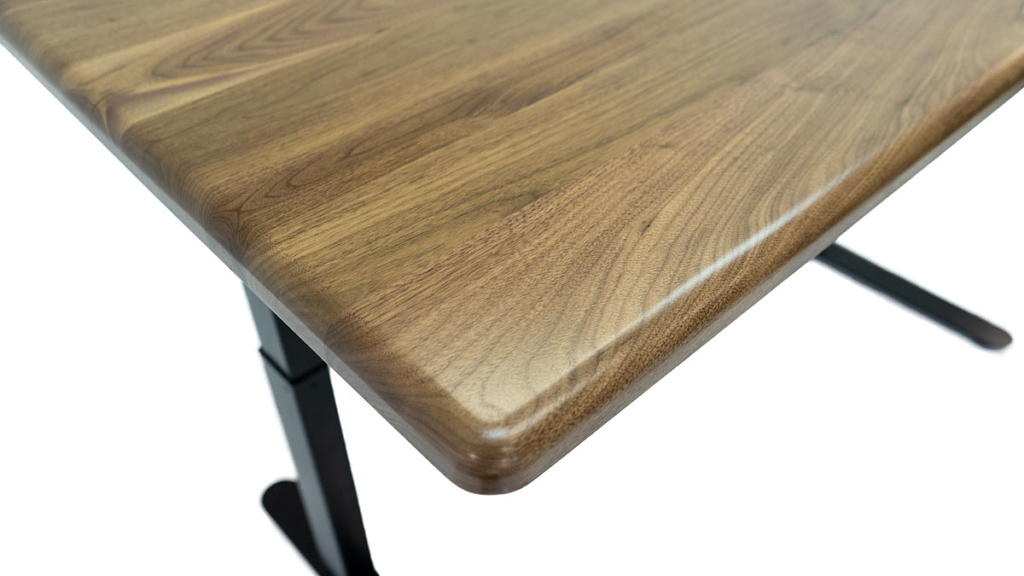
No standing desk manufacturer has yet to offer a true “single slab” desktop made from one very large piece of wood cut from the center of a very large tree. Such slabs are extraordinarily expensive and very hard to find. Whenever you do see them in a furniture showroom, they were typically locally-sourced after a storm brought down a very large tree. We’re going to limit this review to tops you can buy online that are more commonly available and more affordable.
So, what should you expect when you’re buying a “real wood” desktop online? In terms of construction these tops are made by taking planks of real wood, typically 0.75” to 1.75” thick and 4” – 6” wide, and edge-gluing them together to make a solid slab of wood. That means you will see a half-dozen or more separation lines in the grain of a typical real wood desktop. But it will be made of 100% real wood. This is far more cost effective than sourcing a true solid slab from the center of a tree.
As a general rule, more expensive tops will be comprised of a smaller number of wider planks; less expensive tops will be made using a greater number of narrower planks. Walk into any fine furniture store, and this is what you’re going to see 99% of the time, whether it’s real-wood or veneer furniture.
If the lines in the wood bother you, then your best option may be to go with a 3D or HPL-laminated top where the wood grain is an image that is continuous. But let’s be honest, these look-alike tops are fakes. Some 3D laminations, like the Surf(x) laminates made by Omnova, are so convincing that they give real wood a run for the money (and they’re actually more durable to boot).
But if the real McCoy is what you’re pining for, there’s no reason to settle. Having seen all these products side-by-side, we can tell you there isn’t any comparison in the beauty and character of real wood versus conventional laminated MDF. They look the part of their lofty price tags. How lofty? A real wood desktop will likely cost 2x to 10x more than the same manufacturer will sell a conventional laminated-MDF desktop for—even more if you want something truly exotic like mesquite with a faux barkline or a quarter-sawn white oak.
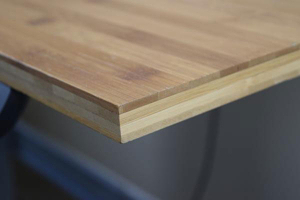 It’s worth taking a moment to explain that standing desks with bamboo desktops, while often marketed alongside other natural wood products, do not fall in the same category as the real-wood products we cover in this article. Bamboo is in fact an engineered product made from a grass, and commonly available cheap variants are produced in hideously environmentally-damaging manufacturing process (there’s a rather large price step-up for bamboo that is responsibly manufactured, and we’ve yet to see one of these sold online). “Engineered” means that many layers are glued and compressed together into thin boards, and those thin boards are then layered at 90-degree angles and glued again, to make something reasonably stable, at least for awhile. Again, cheaper bamboo products are infamous for delaminating and warping over time, whereas the much pricier premium bamboo tops are among the most durable and aesthetically pleasing desktops you can buy. See our full article on the ins and outs of bamboo desktop manufacturing for all the details.
It’s worth taking a moment to explain that standing desks with bamboo desktops, while often marketed alongside other natural wood products, do not fall in the same category as the real-wood products we cover in this article. Bamboo is in fact an engineered product made from a grass, and commonly available cheap variants are produced in hideously environmentally-damaging manufacturing process (there’s a rather large price step-up for bamboo that is responsibly manufactured, and we’ve yet to see one of these sold online). “Engineered” means that many layers are glued and compressed together into thin boards, and those thin boards are then layered at 90-degree angles and glued again, to make something reasonably stable, at least for awhile. Again, cheaper bamboo products are infamous for delaminating and warping over time, whereas the much pricier premium bamboo tops are among the most durable and aesthetically pleasing desktops you can buy. See our full article on the ins and outs of bamboo desktop manufacturing for all the details.
Country of Origin and Sustainability Issues
These days, customers tend to care a lot more about buying American over foreign imports, for a multitude of reasons. When it comes to wood products, many countries, like China, will absolutely devastate an ecosystem in the name of profits, whereas American producers have to comply with more environmental and labor regulations. Even the simple act of shipping heavy lumber around the world (versus efficient transportation lanes between two cities in the USA) has environmental ramifications.
As we’ve seen in the case of bamboo desktop marketing and cheap reclaimed wood desktops, “green washing” tends to happen a lot more with foreign-sourced wood products than with American-made. Bamboo is indeed a highly renewable crop that grows very fast, but the rate of growth of the grass is the least impactful aspect of converting it into a wood panel product from which a tabletop, floor board, or chair can be made.

While marketers may claim their imported woods come from certified sustainable forests, it’s not as easy to check those claims versus an honest, American-grown lumber source; there is simply no reliable international standard. In most cases these sellers don’t bother to mention that their woods are imported, so be sure to ask about the country of origin of any real wood top you’re considering. The domestic real wood desktops we’ve found online are easy to verify as sustainable species, meaning more new trees are planted each year than are being harvested.
Since most low-cost standing desks sold online are made in China, the tariffs and drastically increased costs of deep ocean shipping have also changed the value equation a bit lately. In many cases American-made desktops are now similarly priced to lower-quality and less environmentally-sensitive Chinese products.
Taking a Different “Cut” on Real Wood Options
If you haven’t toured a sawmill, you may not appreciate the differences in how wood planks can be cut out of a tree. A real tree has many imperfections throughout that present a range of figures, including strips, burls, mottles, crotches, curls, and butts. These imperfections give real wood its character. A “rustic cut” of cherry or walnut will include many of these features. On the other hand, a “select cut” of the same tree will be free from these small faults.
Naturally, it costs more to buy a select cut of lumber because there is less ‘select’ material in a tree compared to rustic. Some people really love the rustic look (and lucky for them, rustic cuts are cheaper). Others prefer the perfection of select cuts, and are willing to spend for it.
The important thing when buying a rustic cut desktop is to know that any natural defects in the wood have been properly treated with clear or naturally-colored filler before being sanded down and sealed, so they don’t affect the integrity of the surface. This is painstaking work, but done right the results can be striking.
Lastly, there’s the direction of the cut in relation to the growth rings of the tree. For example, a coveted premium selection is a quarter-sawn cut that shows a natural “flake” pattern in certain species, like white oak. Quarter-sawn wood is famously used in mission or arts & crafts style furniture and Craftsman style homes. As compared to rift-sawn and flat-sawn cuts that are less spectacular, quarter-sawn has growth rings at angles of 45 to 90 degrees to the wide surface. You can’t get as many quarter-sawn cuts out of a tree, so it is naturally more expensive.
What Goes into Making a Desktop, Besides the Wood
This is where we see significant differentiation between the purveyors of real wood desktops. Wood is wood—mother nature controls that manufacturing process—but how it is kiln dried, transported, shaped, sanded, stained, and sealed is an entirely different matter, and we see a wide spectrum in today’s market. The adage “you get what you pay for, and you pay for what you get” applies as much to natural wood desktops as it does to the electric standing base frames holding them up.
For more money, you should expect a more beautiful and longer-lasting product made with more hands-on craftsmanship (versus industrial automation) and more honest, low-VOC stains and sealants. Compared to solvent-based chemicals, these products require more labor and time to apply, so they’re a bit pricier. And while there are zero-VOC products available in the market for those who are sensitive to even the slightest aroma of a stain or sealant, keep in mind that there’s always a trade-off between durability and emissions. These tend to come with a much shorter warranty for this reason. The best compromise? The low-VOC finishing products that are typically used by American producers are ideal for 99% of customers.
Fact: real wood desktops are more susceptible to temperature and humidity variations, scratches and dings than conventionally mass-produced desktops. Desktops made with MDF cores are more isotropically stable than real wood, meaning they have the same strength and thermal expansion properties in all directions, and are thus the least susceptible to dimensional changes with temperature and humidity, much less cracking or warping.
Durability and Real Wood “Character”
Real wood has greater strength in the direction of the grain and is weaker cross-grain. Its susceptibility to temperature and humidity variations varies greatly by species, with woods like maple and cherry being relatively soft and oak or hickory being stiffer and denser. See the Janka Scale to compare the hardness of different wood species you may be considering.
There are two important things to note here. The first is that owning real wood furnitures means it is going to “build character” over time, with dings and scratches being more pronounced than on laminated desktops, and, frankly, that’s what makes them “real” and more coveted by consumers who can afford them.
The second is the way the wood is kiln dried, sanded, and sealed will make a big difference in its longevity. What you want to look for is a desktop that is properly kilned to remove excessive moisture (a step that sadly many solid-wood and reclaimed-wood desktop manufacturers skip entirely) and completely sealed, including on the unseen bottom surface and even through the grommet holes. Some producers only seal the visible top part and edges of the desk slab, leaving the rest of the surface susceptible to humidity changes, and therefore making the entire top more susceptible to dimensional changes and warping over time. For the kind of money you’re going to be investing in real wood, be careful that you don’t get shortchanged on its longevity.
Edging and Grommet Holes
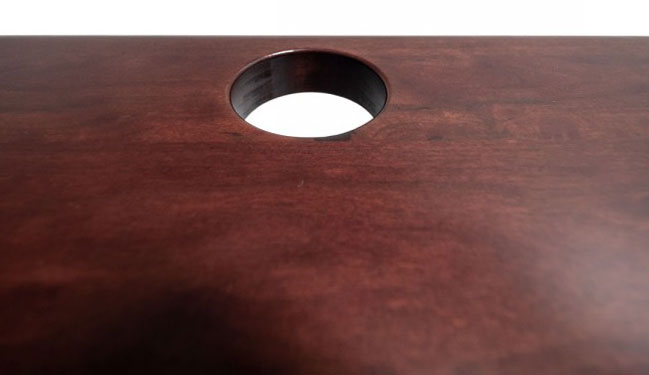
The more basic real wood desktops will be simple rectangles, with hard, 90-degree edges all around. The more premium-priced tops will have an ergo-contoured edging that is more comfortable to lean against, and will be more resistant to dings along the edges from chair arms, etc. Putting contoured edges on a slab of real wood is much trickier than shaping an MDF board on a precision CNC machine in preparation for 3D lamination, and generally requires a lot more hand-sanding to perfect, so expect to pay a little more for such niceties.
Most real wood tops are offered with the option of grommet holes for cable pass-throughs or for installation of optional devices, such as power nodes for bringing power sockets, USB sockets, or wireless charging surfaces to the top of the desk. On cheaper tops, these grommet holes will be rough cut and covered with plastic grommet caps, leaving a lot of surface area exposed to moisture in the air and from accidental spills.
As mentioned above, you really want these inside surfaces to be sealed and aesthetically pleasing enough to leave the cheap-looking plastic grommet caps off altogether. After all, being able to see the wood grain inside the grommet holes is one way you’ll be showing off the fact that your desktop is made of real wood, not laminated MDF.
Speaking of grommets, check out our article on grommet holes, with everything you need to know about the different ways to use them to enhance your workstation, what to look for in your grommet holes, and where to find the desks with the best ones.
Sanding
The sanding of real-wood furniture may sound mundane, but it’s where a lot of the labor cost goes. Some tops are sanded by machine in a single pass, leaving a perfectly flat surface just like a laminated MDF board. And that’s fine, so long as you realize that your real wood top isn’t going to stay that way forever. The thing is you’re dealing with real wood here, which has real variations in texture throughout. Hand-sanding, while more labor-intensive, results in a higher quality end product that has a consistent “hand.”
Staining and Sealing
And that brings us to the all-important differences in staining and sealing. You’ll usually see several stain options on a particular species that is being offered by a desk maker. This can range from a light/medium/dark stain to as many as 10 different stains. In stained woods, you can find a wider array of tones to better match the look of your office or home decor, from browns to reds to blues to blacks. The lighter the natural color of the wood the more stain options will be offered for it (maple, the most popular real wood species for desktops, takes the cake in this regard).
Stains and sealants, necessary as they are, come in a wide range of toxicity, from solvent-based concoctions that’ll outgas nasty VOCs (volatile organic compounds) to non-toxic water-based products. A premium quality real wood top will be finished with a KCMA-rated waterborne sealant, ensuring long life by reducing the effects of humidity changes on the wood. This low-VOC finish protects the natural wood from moisture, chemicals, abrasion and marring, while being safe for workers and the environment (plus it reduces the use of solvents for application and cleaning).
Machine-processed versus Hand-crafted
When it comes to craftsmanship versus automated production processes, you might have guessed by now, our expert reviewers have a strong bias to the handcrafted process. It is definitely slower to produce but like mama’s famous spaghetti sauce, it’s the loving attention that goes into every detail that you just can’t find in a recipe book.
Real wood also has a lot of variations to it, like knots and pitch streaks, that machine processing cannot detect and address as competently as a skilled-eye craftsman. A handcrafted rustic slab will often need careful application of color-matched epoxy to ensure the integrity of the wood doesn’t degrade over time, and that the working surface remains perfectly smooth. This often involves several passes of filling-and-sanding to perfect, and not something you can expect from machine-finished producers (especially imports).
Don’t get us wrong, we’re not against machining in certain parts of the process. For example, a good desktop will be pre-drilled for the hole pattern of the base it will sit on, and this should definitely be done on precision CNC equipment with resolution of at least one-thousandths of an inch. It’s important that the top not only sit correctly on the base frame to avoid tweaking it and damaging the lifting actuators over time, but also that the top itself is well-protected from warping by virtue of humidity and temperature changes. A good, all-around seal is imperative, and will add a gorgeous shimmer to the surface.
What About Reclaimed Wood?
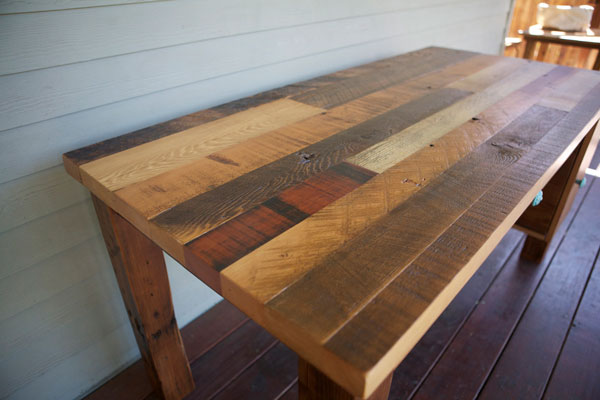
Reclaimed wood is such a huge topic on its own that we’ve had to break it out into a separate primer on Reclaimed Wood Standing Desks. As with solid wood desktops made from fresh-cut stock, when it comes to reclaimed wood you get what you pay for, and with more money you get a more beautiful and durable product, with nicer finishing touches—i.e. species and stains to match the tone of your decor, smoother surfaces, softened edges, plentiful size choices, grommet hole options, etc.
A key point you’ll read about in our primer is that discerning consumers perceive “reclaimed hardwood” to mean something that was originally hewn by early American settlers from original old growth timber, to fashion structures that they lived and worked in, like houses, churches, lodges and barns. If this is what you’re really after make sure to note whether the tops are marketed as “Antique,” meaning at least a century old. Antique reclaimed wood will cost a lot more but be authentically “reclaimed.”
There’s just so much information to dive into when it comes to shopping the very wide range of reclaimed wood standing desk products on the market that we urge you to read the full Reclaimed Wood Standup Desk Review to be completely informed before buying.
Understanding the Offerings in Real Wood
There are three prominent vendors of real wood tops for standing desks today—Fully, UpLift, and iMovR. As our faithful readers know, WorkWhileWalking and iMovR have a unified origin story, and we were excited to announce their entrance into the solid wood top standing desk game. Both Fully and UpLift pair their real wood tops with a commodity Jiecang base, made in China. To our minds that’s a little like installing a Ferrari alcantara interior in a Ford Fiesta, but both companies have had great success with real wood tops. iMovR, in contrast to the other two, pairs its real wood tops with their state-of-the-art American-made Lander base, which arrives 99% pre-assembled, is packed with high-tech features like a built-in health coach, anti-collision that detects tilt and Bluetooth-sync’d smartphone app, and features an industry-leading ten-year warranty.
To learn about the bases, see our comprehensive reviews of the Jiecang base, the Jarvis desk, the UpLift desk, and our reviews of the iMovR Lander desk and Lander Lite desk.
In terms of real wood tabletops, Fully and UpLift offer four standard sizes and iMovR offers eight, in 6” increments that include 41”, 47”, 53”, 59”, 65”, 71”, 77” and 83”. UpLift does offer custom-sized tops cut to the inch to meet your exact needs, if 6” won’t get you close enough. Fully and UpLift do not warranty their tops for anything other than shipping damage, and iMovR puts the same five year warranty on their real wood tops as they do on their 3D laminated desktops. For more information on warranties, be sure to read our primer on How to Compare Warranties on Standing Desks.
iMovR Offerings
iMovR has a robust line of solid wood options with all the usual ergo-contour trimmings they are known for. Offering by far and away the greatest selection of solid wood standing desks, all made-to-order by artisan craftspeople in Michigan, and featuring the highest degree of manufacturing precision, quality and warranty coverage. These surfaces are simply the best you’ll find anywhere for topping a standing desk, and they’re paired only with state-of-the-art, American-made Linak lifting columns.
iMovR – 38 American-grown Species and Stain Combinations
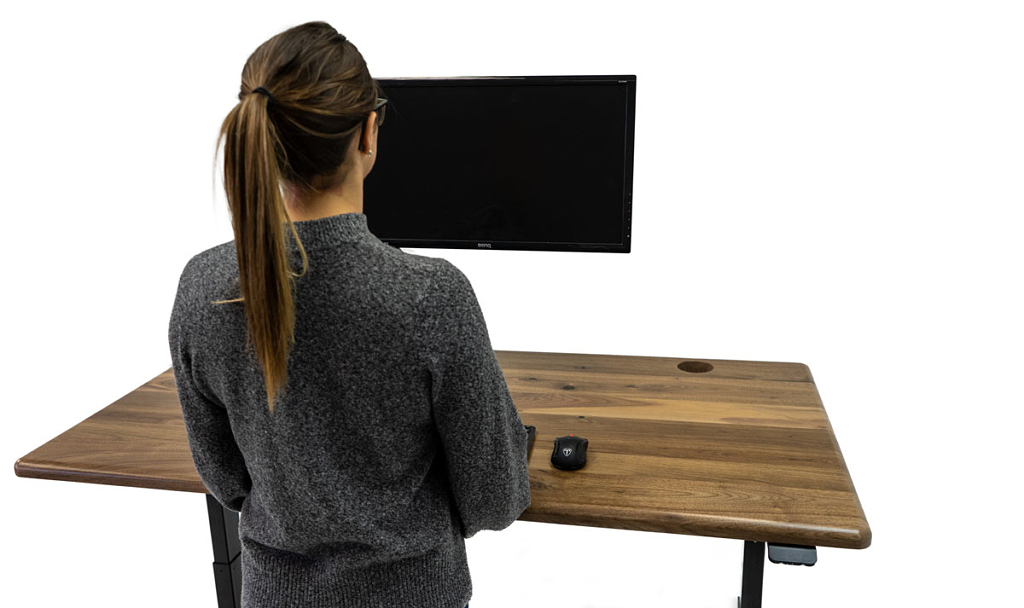
Eight domestic, sustainable wood species are offered including maple, cherry (in rustic or select), walnut (in rustic or select), hickory (aka pecan), red oak, and a very distinctive quarter-sawn white oak. Multiple stains are offered on each species for a total of 38 species+stain combinations, in ten different sizes ranging from 41” all the way up to 95”, for a total of 3800 color/size combinations on the Lander Desk. Solid wood options on the Lander Lite and Lander L-desk add thousands more. And coming soon are 36 different conference table top sizes, adding another 1,300 solid wood options.
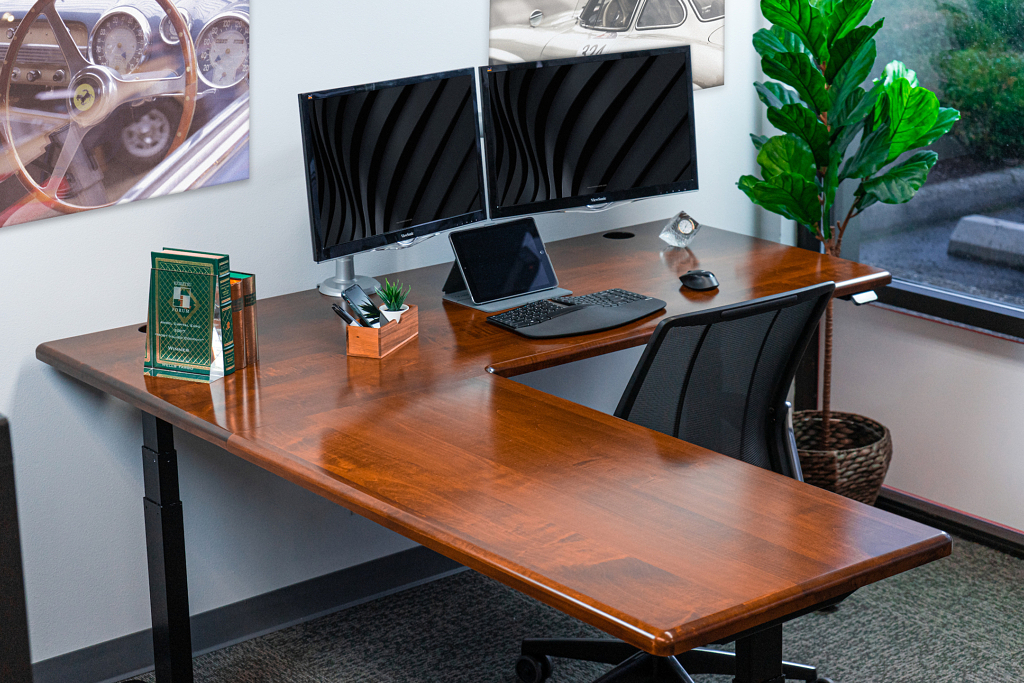
Unlike the plain-Jane rectangles offered by Fully, UpLift and Ergonofis, these iMovR tops are ergo-contoured on all four edges, making them more comfortable to lean against and less susceptible to dinging from chair arms, not to mention jaw-dropping gorgeous. Options include dual grommet holes that are completely stained and sealed, and iMovR’s popular, built-in SteadyType keyboard tray (patented). There’s even the option of staining the underside of the desktops for the most discriminating customers.
The iMovR tops are handcrafted in Michigan through a detailed seven-step process using honest waterborne stains and sealants. The result is a stunning “shimmer” and luxurious “hand” when you compare these tops to others in the same price range.
iMovR offers two different desk lines with solid wood, the Lander and Lander Lite. The Lander Desk and Lander L-Shaped Desk ship with more traditional 1.25″-thick slabs, while the Lander Lite ships with more economical 3/4″-thick slabs that better fit a modern décor. The Synapse conference table line is expected to launch in solid wood versions in late 2022, as well.
Stained and Sealed
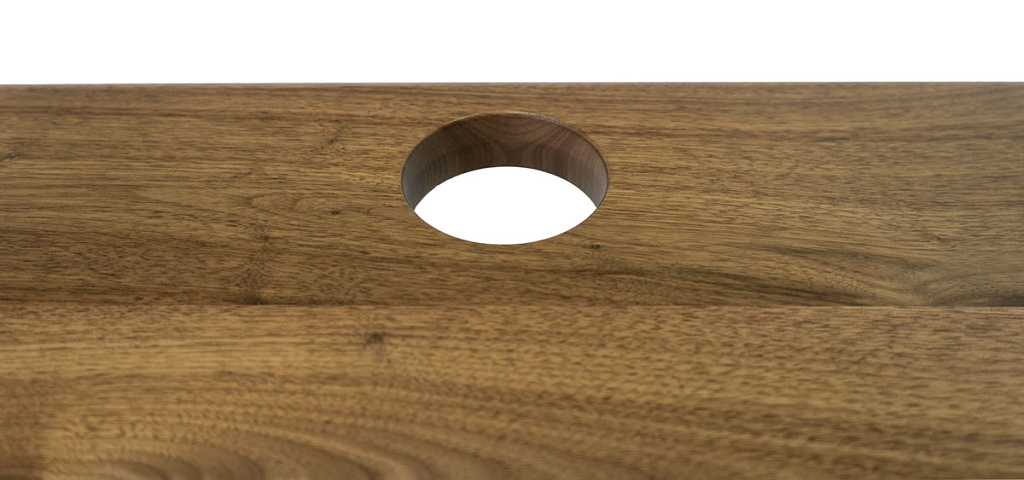
Unlike the Fully, UpLift and Ergonofis tops, iMovR completely seals their desktops, even through the insides of the fully-finished grommet holes. In fact you wouldn’t want to cover these grommet holes with ugly plastic caps, you’d want to show them off. But most importantly, the multi-step sealant process is designed to protect the wood from humidity changes that can cause partially-sealed tops to crack or warp. This is indeed a true heirloom-quality finish, and for only a very slight price premium over UpLift’s domestic solid wood offerings.
We have to say, given the sizeable investment that a solid wood desk entails, we find it kind of shocking that some desk makers choose to skimp on sealing the unseen portions of the desktop (i.e. the bottoms and inside the grommet holes), all in the name of cost savings. Any experienced fine wood artisan will tell you that moisture attacks a desktop from all sides, and therefore a beautiful piece of wood like this should be completely sealed for protection.
99% Pre-assembled Lander Desk Frame
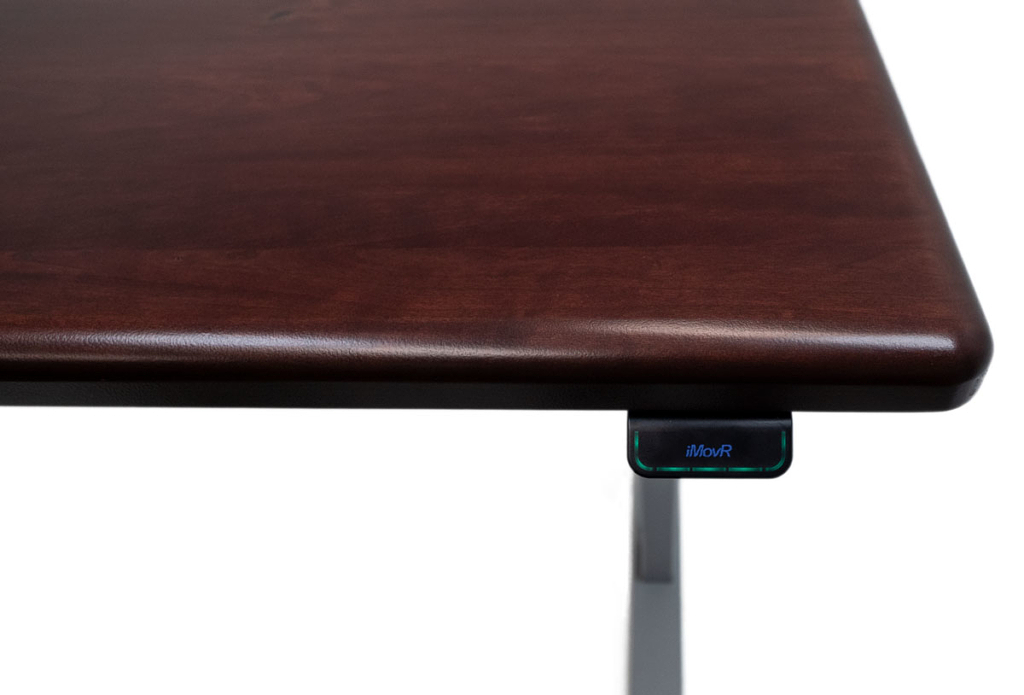
In further stark contrast to Fully’s, UpLift’s and Ergonofis’s offerings, the iMovR tops are sold with a state-of-the-art American-made “Lander” base. The Lander line is factory pre-assembled and tested, allowing users to get their new standing desk going in a matter of minutes with no tools required (see our Lander Desk Review for full details and video of the assembly process).
The ultra robust packaging these tops come in will take significantly longer to pry open than the desk will take to assemble the entire desk. While we want to whine about the packaging the fact is we’ve seen so many tops damaged in shipping over the years that we have to appreciate the attention to detail and expense iMovR has gone through to ensure a great customer experience.
The Lander desk is loaded with other high-end features that make a lot more sense when packaged together with a real-wood desktop, like a smartphone app that connects to your desk via bluetooth, a built-in “health coach,” ultra-quiet motors with a blazing 1.6 inches-per-second transit speed, and a lab-verified 360 lb weight lifting capacity. The Lander’s stability and 55” top-end height range is unparalleled; there’s just more American steel in this base than any other we’ve ever tested.
In addition to the thousands of customized made-to-order options, iMovR also offers several Lander configurations through its QuickShip program. It pre-manufactures QuickShip desks in the most popular sizes and colors so they can ship immediately after an order. Lander QuickShip solid wood options are in Espresso Maple, Natural Maple or Natural Rustic Walnut, in 59″x30″ or 71″x30″.
iMovR offers 4”x6” real wood samples for $5 apiece plus $3 shipping and handling fee, which they’ll deduct off the cost of your desk if you buy one.
A New Lower-Cost Alternative to Solid Wood: Baltic Birch

An exciting new alternative to solid wood that runs about 1/3rd the cost, looks as beautiful as maple and is actually much more stable and strong than natural hardwoods is Baltic birch. iMovR has recently launched a new line of designer standing desks (their “Baltic Line“) using a gorgeous, top grade (B/BB) 12-ply birch panel, including the highly unique Captain’s Desk and Ensign’s Desk, both of which we recently reviewed. Baltic birch like this has been used for hundreds of years by European makers of fine cabinetry and musical instruments because of how durable, stable and precisely machinable it is. It also takes stains as well as any solid hardwood plank does.
Baltic birch looks almost identical to maple, but at a far lower cost and greater stability as compared to solid planks of natural hardwood.

The birch panels are made up of a dozen 1.5 mm-thick sheets of veneer that are bonded together in alternating grain direction. This makes for a void-free core that is exceptionally strong and stable, much more so than a plank of natural hardwood. While technically a “plywood” this is not the same animal as you’ll find in the bins at Home Depot.
Ergonofis Offerings

Montreal-based Ergonofis is a premium brand in the standing desk industry, like iMovR. They’ve been offering solid wood desks to Canadian customers, sourcing from Canadian forests, for nearly a decade. While they don’t offer a very broad selection of species, stains, shapes and sizes, nor produce their tops to the same level of ergo-contouring and protective sealing as iMovR does, their solid wood products are…solid. In terms of quality they’re in the next tier down from iMovR and yet above those sold by Fully and Uplift. Like iMovR, Ergonofis also uses premium-grade Linak lifting bases for their solid wood desks, as opposed to the cheap, commodity-grade Jiecang lifting bases that Fully and Uplift put under their solid wood tops.
We’ve just completed our full lab test review of the all-new Ergonofis Sway solid wood standing desk, which you should definitely check out. The Sway is made with a solid rectangular top while the Alive features a thicker live-edge top. (Stay tuned for our upcoming review of Ergonofis’ Alive desk by subscribing to our free newsletter.)
UpLift Offerings
UpLiftDesk has two categories of solid wood desks. The premium-priced “custom solid wood” desks are made-to-order and take 10-12 weeks to product. These are orderable in sizes ranging from 42″ to 90″ wide, and 30″ deep. They also offer less expensive “in-stock solid wood” desks which are made using Asian-sourced tops that have to be shipped over in containers and warehoused. These are available in limited sizes as a consequence—and some of the “species” are actually engineered woods of questionable quality—but these desks ship fast.
Like their arch competitor, Fully, Uplift sells only commodity-grade Jiecang bases, even with these pricey solid wood desktops. This has puzzled us for many years… why would you put a beautiful, expensive solid wood desktop on a cheap Chinese-made base? In contrast, the other two players in this category—iMovR and Ergonofis—put top-tier American-made bases under their solid wood desktops.
UpLift – “In-stock” Solid Wood Desks (Imported)
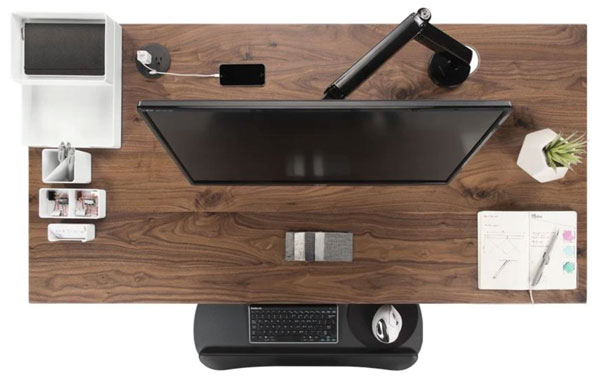
The new “in-stock” offerings are designed to hit a price point nearly identical to what Fully charges for their minimally-crafted, albeit domestically-sourced maple tops. These include the so-called “butcher block,” meaning they’ve been glued together from a lot of small blocks of 1.5″-thick wood. You have to like the look, which is sort of a patch quilt affair, but these are the least expensive. Species include acacia, birch, saman, walnut and reclaimed fir and birch. Then there are the more traditional solid wood slabs made of 5″-wide, 1.75″-thick slats glued together, including ash, African mahogany, thermo ash, pheasantwood and walnut at a significantly higher price point.
One big advantage of these imported offerings is that they ship relatively quickly, being stocked at UpLift’s warehouse rather than being made-to-order as with Fully’s and iMovR’s real wood tops or UpLift’s “Special Order” tops. UpLift does not disclose the countries of origin or anything about their production processes, nor does it provide a warranty on any of its tops, including these real wood varieties (other than for shipping damage).
UpLift – “Custom” Solid Wood Desks – Upscale Options
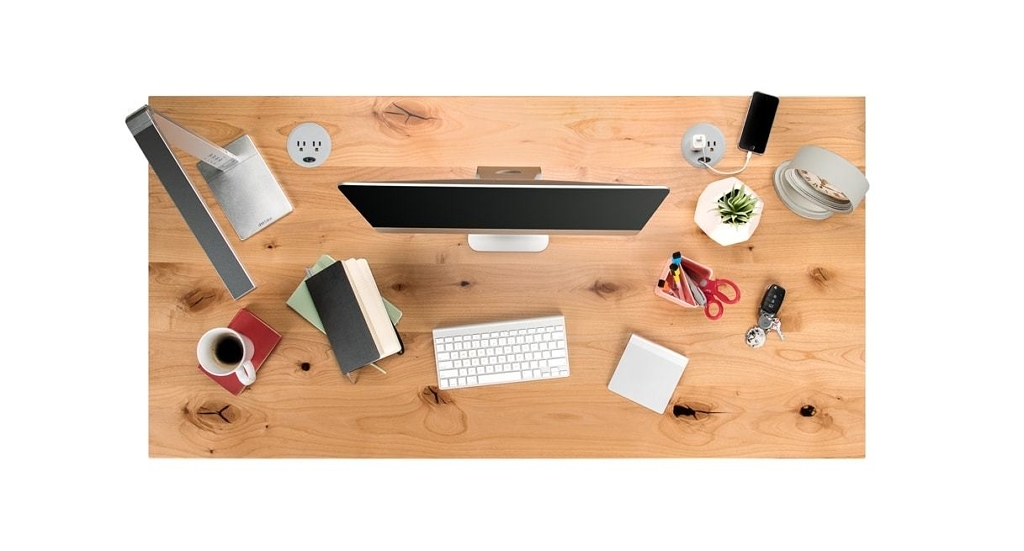
On the upscale end UpLift has what they call their “custom” wood tops, which are made domestically using real wood. These are priced in a similar range to iMovR’s real wood tops but lack the nicer touches like ergo-contouring and complete sealing, and don’t come in as many sizes and colors. Grommet holes are offered as an option. The real kicker, though, is that UpLift now quotes 10-12 weeks lead time for all of these domestic real wood tops. That used to be the exception, not the rule.
This seller does more real wood species than the other two makers, in a wide range of prices, nine of them in all, including ash, dark ash, cherry, maple, walnut, pecan, white oak and sipo mahogany. But these all come in only one finish; there are no stain options.
In contrast, iMovR offers only 8 species but these translate into a total of 38 options because of the additional staining options they offer on each species. Fully offers only maple, and only in five stain colors. And Ergonofis offers only three species in three sizes of its solid wood tops, with no stain options either.
Uplift sneaks in an imported “premium bamboo” top (versus their ultra-cheap, bottom-of-the-line bamboo top) into this custom solid wood category-though as we say above, bamboo is a grass that is engineered into a wood panel, not a real wood. It doesn’t really belong in this category with domestic real wood tops. No details are provided on what makes this premium bamboo better than the super-cheap standard offering.
Uplift – Faux “Barkline” Option
[Editors’ Note: on a recent search on Uplift’s website we were unable to find the cedar and mesquite “faux barkline” live-edge desks. It is possible that these have been discontinued. Just in case they’ve only been temporarily delisted we leave this last section of Uplift’s solid wood desk offerings intact below.]
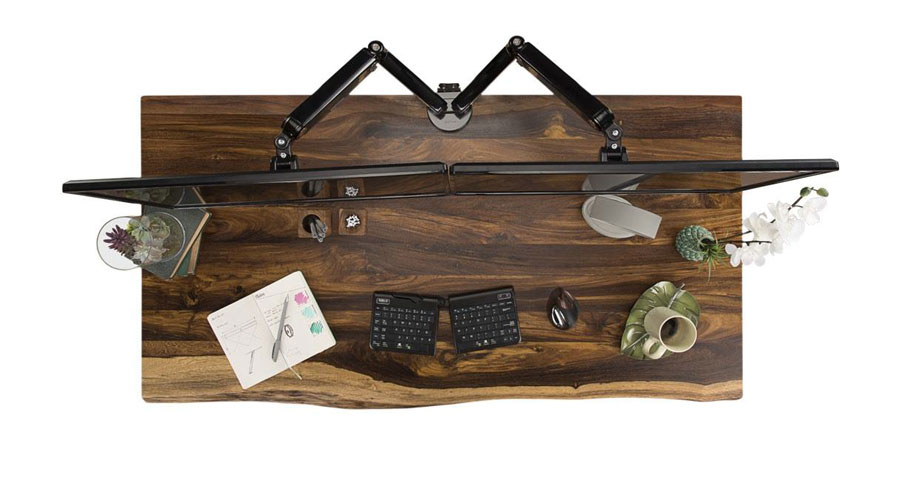
On the cedar and mesquite species UpLift offers the unique option of having a faux “barkline” on either the front edge of the top, back edge or both, intended to make it look like a super-expensive solid slab with a “live edge”. Except that it’s still made of planks edge-glued together, so that kind of dulls the whole live edge impression. We’re not sure who would like to have an uneven user edge on their standing desk, but this is definitely a unique look that only UpLift offers. This might be a better match for a conference table than a desk.
Our review staff is throwing down a yellow caution flag on these tops, however, given the disclaimer language on UpLiftDesk.com’s website: “If the air in your area is especially dry, your wood desktop could be at increased risk of cracking and splitting. Wood naturally expands and contracts depending on the amount of moisture in the environment, and without enough humidity, the moisture in your desk can evaporate, leaving it vulnerable to warping… If your desktop does crack or split, we’re happy to send you a repair kit to fill the affected areas. If potentially repairing your wood desktop isn’t something you’re comfortable with, we recommend that you take a look at our Bamboo, Eco, or Laminate desktops instead.”
Warranty & Shipping
Like the lower-cost imported solid wood tops, these premium domestic tops come with no warranty coverage, and there’s no disclosure as to the chemicals and processes used. For this kind of price, a consumer should expect a completely sealed piece of wood that avoids a premature end due to warping or cracking.
While the company does not offer color samples that you can keep, they do offer a “rentable” box of solid wood color samples for $45 (if you hold onto it, they’ll bill you $300).
Desktop Thickness
Depending on how you look at it, one big differentiator for these UpLift solid wood tops is that they are 1.75” thick. Most desktops used in standing desks are 0.75” to 1.25” thick, so these will weigh substantially more than you might expect. The good news is that the extra thickness makes them less susceptible to dimensional instability or warping from exposure to humidity. The bad news is that the larger sizes of some of these species will put a serious strain on the Jiecang base, or at least significantly limit the weight of other items you can add to your desktop. It also means you’re paying for a lot more embedded shipping cost in the price. And you’ll want to make sure you’ve got some help getting the top off the pallet, unboxed, and assembled to the desk base.
Weight Considerations
See the end of this comparison review for guidance on calculating the weight of any given desktop from these three manufacturers. But let’s just take one example here. While the Jiecang base is marketed as sporting a 360 lb lift capacity it came nowhere close to being able to handle that kind of weight in our lab testing. And that’s before considering the side loading stresses imposed on a typical standing desk base. An 80”x 30” pecan table top will weigh a whopping 155 lbs. Even getting that kind of top into your office will be a strain, but this is more than twice the weight of a laminated MDF desktop, and really pushing the limits for a commodity, Chinese-made standing desk base.
Fully Offerings
Fully – Maple Option
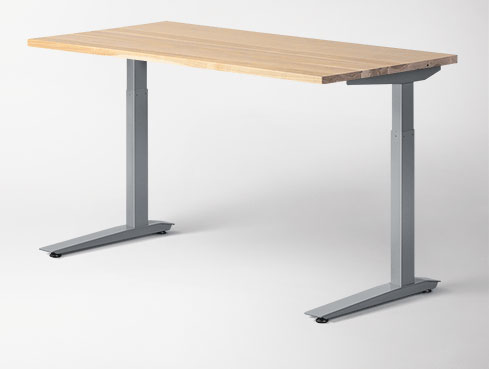
On their Jarvis desk line, Fully offers three real wood options. The most popular is their maple desktop, which comes in either a natural or walnut-colored stain. It comes in four sizes: 48”, 60”, 72” and 78”; all sizes 30″ deep. The tops are plain-Jane rectangular in shape with optional dual grommet holes, but no ergo-contouring. Fully uses water-based, all-natural stains, which are then sealed with a polyurethane clear coat. Fully sources these maple tops from sustainable forests in the US midwest.
Fully also offers a designer desk, the Albright, that has a maple desktop with two built-in drawers on top of the desktop. It comes in a single 60″ x 30″ size.
While these are relatively inexpensive compared to the domestic real-wood tops from UpLift and iMovR, they do cut cut quite a few corners on the quality. Most importantly the tops are only sealed on the visible surfaces. While staining the bottom side of a desktop is not something you should expect, sealing is. This protects the wood from variations in humidity that can eventually cause it to warp.
Since Fully doesn’t provide a warranty on its desktops, this lack of comprehensive sealing is a yellow caution flag for our expert review staff. When you’re in the price range of real wood desktops, you’d expect more of an heirloom quality in craftsmanship. But as we said above, you get what you pay for. This is the low end in domestic, made-to-order, real wood tops. The maple tops ship in 2-3 weeks.
For some reason Fully narrowed its offering of solid wood color stain options from five to just these two since their acquisition by Knoll, as part of a thinning out of selections available to the online buyer. We suspect this may be due to their wanting to create some distinction between what they offer to the retail online customer versus what Knoll’s commercial contract dealers, who typically work through interior designers and architects on large projects, can offer corporate clientele.
Fully – Premium Oregon White Oak Option
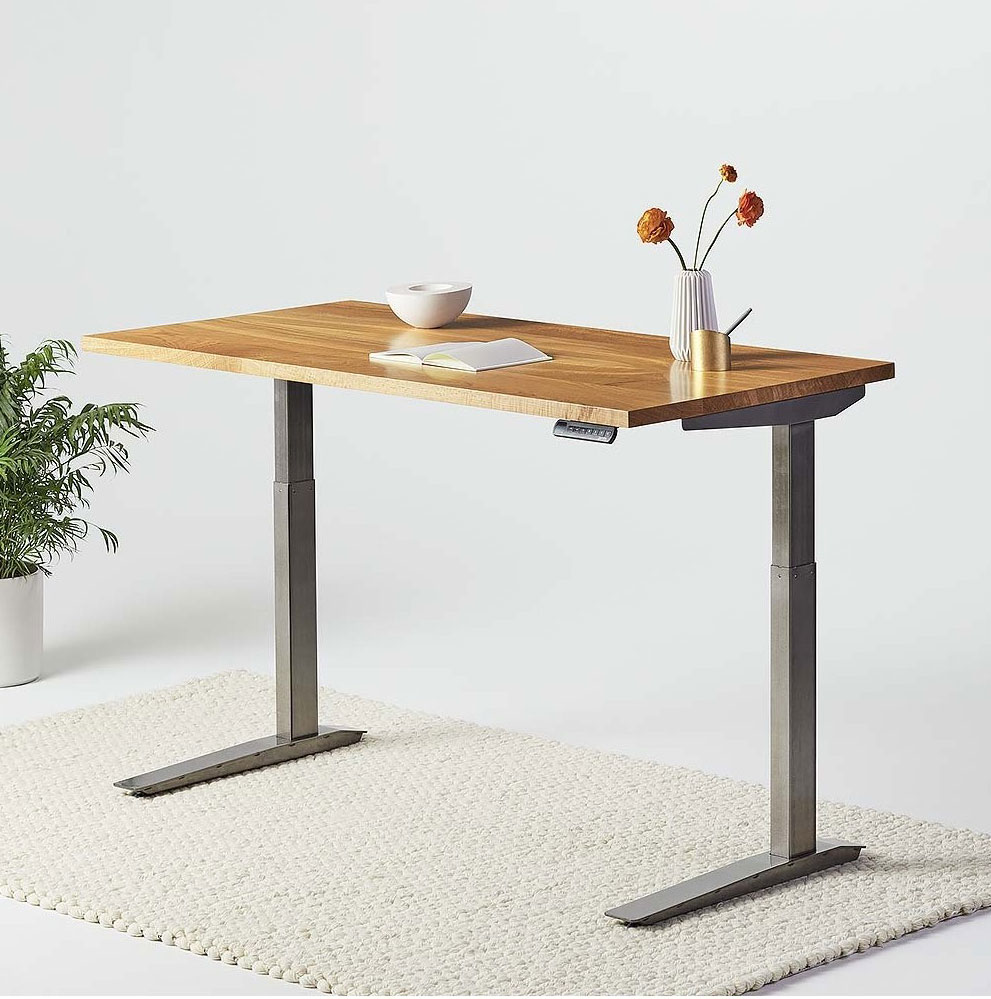
The Jarvis is also offered with a super-premium Oregon White Oak top, in the same four sizes but no stain options, that costs about twice as much as the maple tops. Fully is based in Portland, Oregon, so this top has a nice backstory to it in terms of how it is grown and harvested. The tops are also plain-Jane rectangles with no ergo-contouring or the option of grommet holes. The Oregon White Oak desks ship in 4-6 weeks.
Fully – Designer Ply

The Jarvis is also now offered with a Designer Ply top. This option has a laminate top and exposed ply edge. The core ply is made from cross-laminated Baltic birch. It comes in four sizes, 30″x24″, 42″x27″, 48″x30″ and 60″x30″. The laminate is available in seven colors: black, classic blue, evergreen, moss, pale pink, peak and white.
The Baltic birch BB grade, which is a step down from the top grade B/BB that iMovR uses. Read our primer on birch standing desks for a full explanation, but Fully’s BB grade is the second-best grade. BB means that the face and back veneers are both single pieces. Face and back veneers can have 3-6 color-matched patches and some light streaks. There may be tight pin knots.
Burotic Offerings

Burotic lists three different desk as their solid line. However they are basically all the same desk with the only difference being the type of wood used.
The solid wood standing desks by Burotic feature premium quality solid-wood maple, walnut, or cherrywood desktops mated with not-so-premium basic electric lifting base made in China. The company promotes its five business-day ship time (limited to the Quebec area) as its main differentiator from long-established competitor Ergonofis, who also provides very aesthetically pleasing solid wood tops out of Canada paired with a premium-grade, American-made lifting base. A more impressive differentiator, however, is the option of easily configuring and pricing out a custom-sized solid wood standing desk, albeit with a 4-7 week wait. This is not something we’ve seen from any other desk maker anywhere.
Things to Know About Real Wood Desktops
The first thing to note is that your desktop will not look exactly like the one in the picture. Every tree is unique, as nature intended. Even if you do order a sample piece for color matching, you should be fully aware that grain patterns and color tone can vary widely. This is all fine and good; it’s a testament to real wood’s unique character.
Depending on the kind of sealant, lacquer, or polyurethane used to give your desktop a nice protective sheen, these can take a month or more to cure to their full hardness. You’ll want to avoid tightly clamping monitor arms to the desktop, for example, or at least insert a piece of felt in between the metal and the wood and leave loosely tightened to avoid damaging your still-curing top. After a few weeks, you can tighten things down, but just be aware that real wood is softer than laminated desktops, so don’t get too aggressive on the clamping.
Stained tops will usually not be stained on the bottom surface, which no one ever sees. But they should be sealed to protect from humidity damage on the top, bottom, edges and inside the grommet holes, to maximize the lasting value of your investment. Some are, some are not, as we’ve noted above respective to each manufacturer. iMovR uniquely offers two upgrade levels of staining on the bottom side of their solid wood desktops, an inexpensive spray coat as well as a full heirloom staining to the same level of perfection as the top side.
If you’re looking at adding a particularly heavy desktop to your standing desk base, you’ll want to make sure it can really handle the total weight and weight distribution you plan to lift. Read our complete guide to Why Weight Ratings on Standing Desks Really Matter, and then check the weight of your prospective desktop using the table below. Note that the ruggedized cardboard boxes these tops are typically shipped in will add a lot to their weight and dimensions for shipping purposes.
For comparison’s sake, most standard desktops are made with an MDF core that will weigh roughly 4.25 lbs per square foot (assuming 1” thickness; adjust accordingly for thicker or thinner tops). There is some variation in this with lower-quality (i.e. lower-density) MDF boards such as are often found on Asian imports; they can be up to 20% lighter.
Solid Wood Top Weight Comparisons
A note about how much a real wood desktop is really going to weigh. There will be natural variations in growth and moisture content from piece to piece, that just goes with the territory. Also the advertised thickness of these tops are based on the raw lumber dimension before sanding and application of stains and sealants, so if your 1.25″ desktop comes in at 1.2″ after finishing there will be slight variance from the published weight. We’ve provided the weights below so that you can evaluate approximately how much load each desktop will place on the lifting base. See manufacturers’ websites for shipping weights including packaging and pallet, as these will be greater.
Fully’s Solid Wood Tops (1.25” thick)
Maple: 3.75 lb/sq ft
Oregon White Oak: undisclosed
UpLift’s Solid Wood Tops (1.75” thick)
Cedar: 4.4 lb/sq ft
Mesquite: 8 lb/sq ft
Ash: 7 lb/sq ft
Cherry: 5.3 lb/sq ft
Natural Maple: 8.1 lb/sq ft
Walnut: 5.6 lb/sq ft
Premium Bamboo: 6.1 lb/sq ft
Pecan: 9.3 lb/sq ft
White Oak: 7 lb/sq ft
Sipo Mahogany: 6 lb/sq ft
UpLift’s Solid Wood Tops (1.25” thick)
Maple: 3 lb/sq ft
Cherry: 3.65 lb/sq ft
Walnut: 4 lb/sq ft
Hickory (Pecan): 5.25 lb/sq ft
Red Oak: 4.4 lb/sq ft
White Oak: 4.75 lb/sq ft
iMovR’s Solid Wood Tops (1.25″ thick, Lander)
Cherry: 3.6 lbs/sq ft
Maple: 4 lbs/sq ft
Walnut: 4 lbs/sq ft
Red Oak: 4.6 lbs/sq ft
White Oak: 5.0 lbs/sq ft
Hickory: 7.5 lbs/sq ft
iMovR’s Solid Wood Tops (0.75″ thick, Lander Lite)
Cherry: 2.2 lbs/sq ft
Maple: 2.4 lbs/sq ft
Walnut: 2.4 lbs/sq ft
Red Oak: 2.75 lbs/sq ft
White Oak: 3.0 lbs/sq ft
Hickory: 4.5 lbs/sq ft
Completing Your Ergonomic Workstation
Acquiring the best standing desk for your decor, budget and performance requirements is Step One. But making it a true ergonomic workstation involves adding the appropriate accessories you’ll need to keep your body in a correct posture, and have a neat and tidy setup. Check out our comprehensive guides to monitor arms, keyboard trays, anti-fatigue mats, ergonomic seats, cable management kits, power management modules, foot rests and under-desk treadmills for both expert advice and lab-tested product reviews of options in each of these categories.
Looking For More Standing Desk Reviews?
• Quick Install Standing Desks


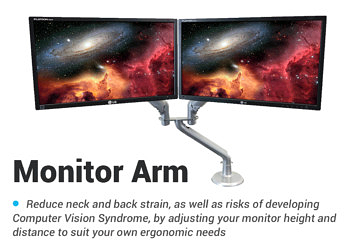
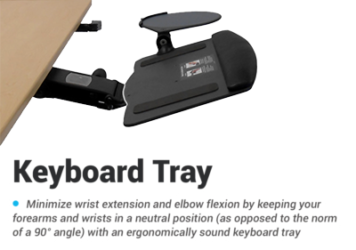
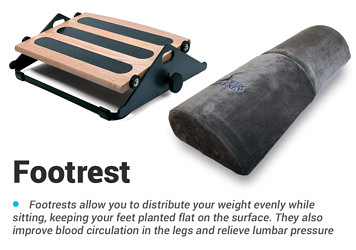
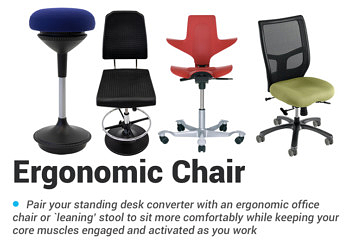
0 Comments
Leave a response >